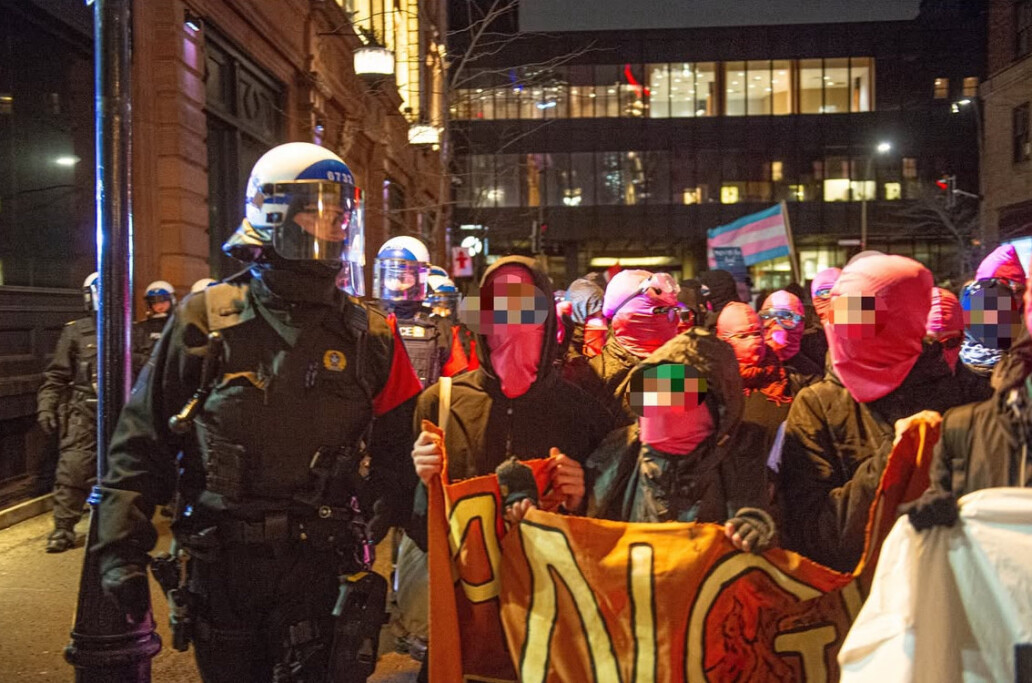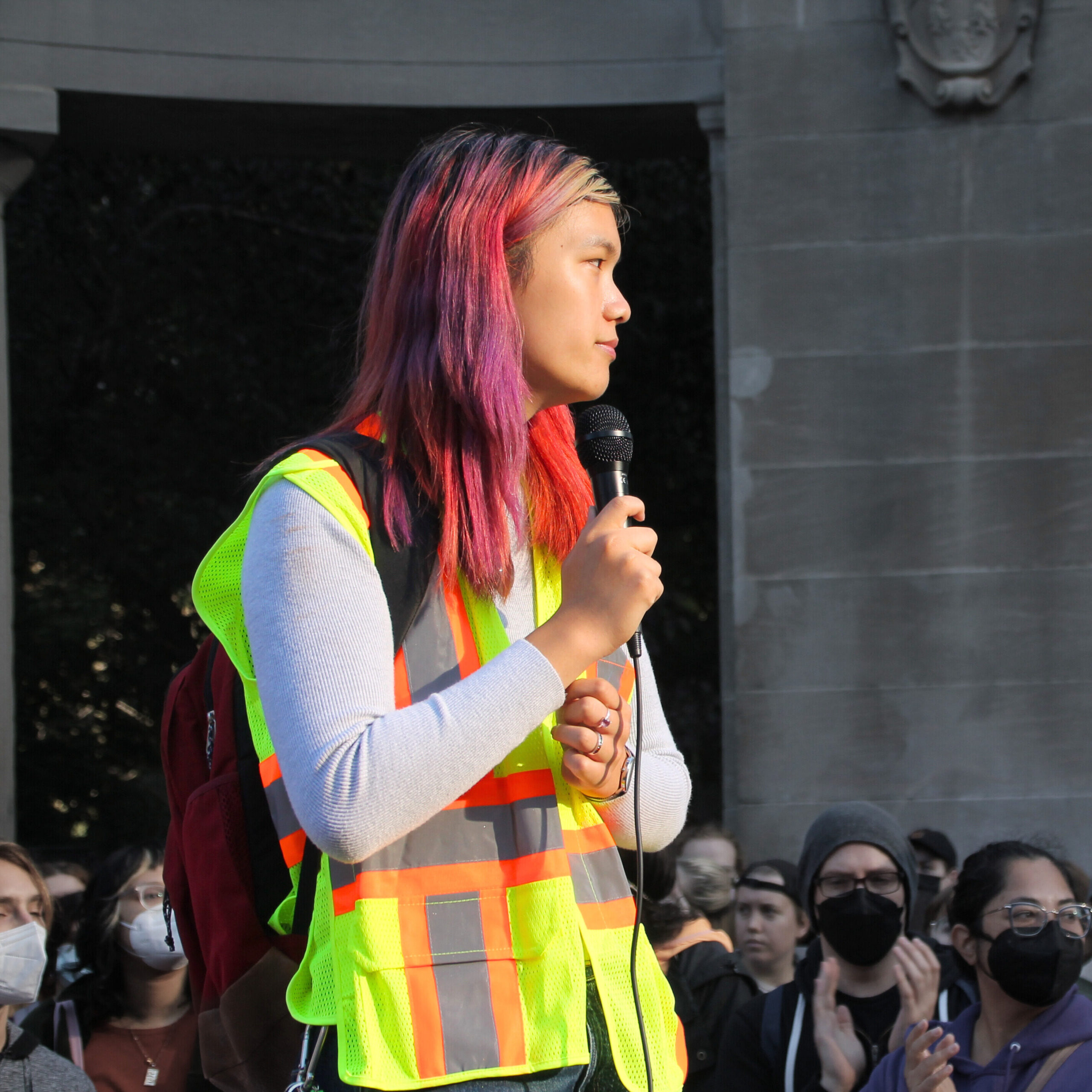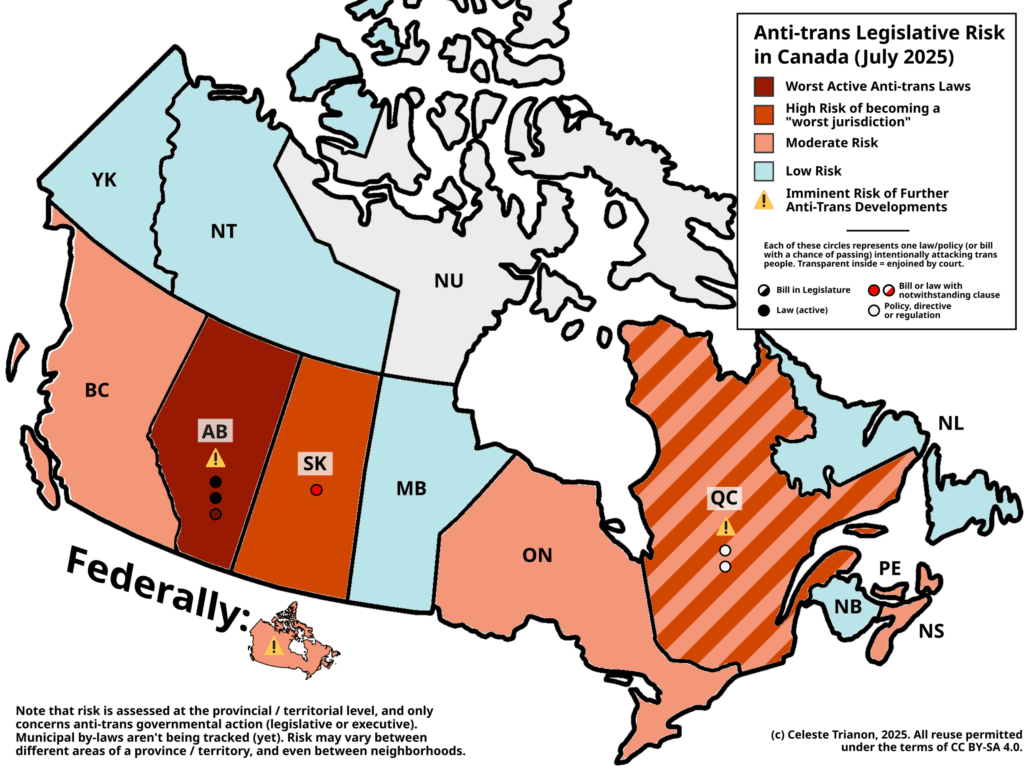We’re halfway across 2025, a year which already is living in infamy as a year of attacks and rollbacks against trans people’s human rights. In Canada, despite some positive developments, we’re not exactly spared from it either. The risk of anti-trans developments remain, in particular in Canadian jurisdictions where right-of-centre governments are in power. Yet, there is reason for hope, especially as some provinces take a stance of leadership which is desperately needed in these rough times.
Changes since January 2025
- Federal: High risk with warning → Medium risk with warning
- Québec: Medium risk with warning → Medium/High risk
- New Brunswick: Medium risk → Low risk
About this map
Since I began tracking anti-trans developments in Canada (as early as 2021, when I was fighting against the initial iteration of Québec Bill 2), I’ve had people ask me: “I’m planning on moving to Canada, where should I move?”. This question, unfortunately, has been asked to me way too many times since January 2025, when Donald Trump seized power in the United States: promptly, our southern neighbours have become a no-go zone for trans people, with hundreds of thousands of internally displaced persons and (increasingly) refugees and de facto refugees. This question is equally relevant to trans Canadians themselves, as well as other trans migrants, who wish to be able to live and thrive in an environment where their existence isn’t consistently questioned.
I created my original anti-trans risk map in September 2023, inspired off of Erin Reed’s anti-trans risk map, as an exercise in visualizing anti-trans hate across Canada. At the time, nationwide protests against trans participation in public life were taking place, and Saskatchewan would become the second Canadian jurisdiction introducing such measures — whilst my home province of Québec promised to introduce its own homegrown brand of government-administered hate, a development which just occurred back in June.
Anti-trans legislation in Canada, whilst taking forms that are different from the U.S., remain similar: examples include gender-affirming care bans, Pride flag bans, and forced outing laws. Legal strategies used to defend such inhumane laws are almost equivalent. The influences behind anti-trans groups, both foreign-funded and domestically grown, are so marked that the Canadian Security Intelligence Service had to publish its own warning.
My focus is on documenting risk for both trans youth and adults, with the assumption that both are correlated. Most anti-trans legislation (and anti-2SLGBTQ+ legislation at large), within the Canadian context, either targets trans youth (targeting them either because they are under the age of majority, or because they are attending school) or trans women (see: transmisogyny).
New to this update: this map also divides anti-trans legislation into two categories: legislation with anti-trans intent (where the law is motivated by anti-trans animus), and legislation with anti-trans effect (laws which have a disproportionate effect on trans people, for instance a name change ban for people with criminal records). Whilst my focus is still on the former (which will be recorded using dots on the map itself), this change allows for bills and laws that will clearly jeopardize the well-being of trans people, such as BC’s Name Amendment Act No. 2 (2024) and the federal Strong Borders Act, to nonetheless face the criticism they deserve.
Note that this map only tracks legislated hate, and not the relative safety of different communities for trans folk across Canada. The unfortunate truth is that it’s extremely difficult to map out, say, the occurrence of hate crimes or other forms of hate. Do not rely on this map as a sole gauge of the state of transphobia in Canada; there are a lot of minute details which I simply cannot capture in one map!
Methodology
First and foremost, all jurisdictions are presumed to be of ‘moderate risk’. This should be understood as the default, and already takes into account the generalized social climate of anti-trans hate in Canada. From there, I rate each jurisdiction using qualitative measures, being notably the reach and severity of anti-trans legislation, as well as what the local Conservative Party (or equivalent) is discussing. Both the policies of the current party in power, the ones of any opposition parties with a certain likelihood of forming government, and polling for upcoming elections (with a higher weight going to imminent elections) are evaluated whilst qualifying a jurisdiction’s level of safety.
Any bill, policy, or law which actively harms a significant proportion of the trans community, or a socio-political climate favorable to making such legislation pass prior to or soon after the next elections, will bump a jurisdiction to ‘high risk’. The ‘worst anti-trans laws’ qualifier is reserved for jurisdictions which either ban gender-affirming care for trans youth, forcibly out trans youth to their parents, or otherwise has a combination of anti-trans laws and policies creating a climate so hostile to trans people that it would be analogous to a ‘worst jurisdiction’ under Erin Reed’s map.
On the other side of the spectrum, the ‘low-risk’ qualifier is reserved for jurisdictions which have either created policies and proposed & implemented laws supporting trans well-being, or shown to be willing to actively defend trans youth. Given that more porous nature of Canadian federalism than American federalism (for example, the Canadian federal government controls criminal law all across the country, unlike the U.S., where both states and the federal government have jurisdiction), “shield laws” per se can’t really exist in Canada, but any steps taken by a given government to defend trans people will be taken into account.
The worst jurisdiction: Alberta
Alberta continues to be the only Canadian jurisdiction to get the “worst anti-trans laws” label attached to it, for two main reasons: Alberta Bills 26 and 27, a ban on gender-affirming healthcare and a forced outing bill respectively. The latter also serves as a de facto sex ed ban.
Bill 26 has been temporarily enjoined in court, thanks to the efforts of Skipping Stone and Égale Canada, which launched a court challenge the day after the bill received royal assent. The Canadian Medical Association has also launched its own lawsuit over said bill. However, the Alberta government has both shown its intention to appeal said judgment, and use the notwithstanding clause — a move deemed “cruel and unnecessary” by Amnesty International Canada. Other moves by the United Conservative Party, the far-right party governing Alberta, includes drag bans, gender marker change bans, and further leeway for on-campus hate speech — moves which suggest that Alberta will not back down, no matter what the Canadian Charter of RIghts and Freedoms states.
Bill 27 has not been challenged in court thus far, but would likely face such a challenge in the months to come.
One another law targeting trans people in Alberta is active right now: Bill 29, a sports ban. Its regulations (and therefore, implementation), specify that any female athlete, age 12 and up, must be able to prove that they were “born female” to play; forces sports organizations, including recreational ones and ones who wish to stay inclusive, to implement a policy stating as such; and allows for vigilantes to challenge any female athlete’s sex assigned at birth, a measure that will inevitably lead to more transphobia both through the systematic exclusion of trans women, and the creation of a broader environment of “gender policing” that’ll affect all women athletes.
Finally, Pride flag bans implemented by the towns of Westlock and Barrhead back in 2024 remain active.
In second place: Saskatchewan
Saskatchewan continues to stand in the “high risk” category. Its unprecedented use of the notwithstanding clause of the Canadian Charter of Rights and Freedoms in Bill 137, a mechanism shielding laws from judicial review for breaches of fundamental freedoms as simple as the right to life, liberty and security of the person to impose a forced outing bill, cannot be understated. Trans youth will inevitably struggle in school owing to this law, as they face the risk of prejudice (though not forced outing). Even though Scott Moe, leader of the Saskatchewan Party, has backed down on his proposal to institute a change room ban for trans youth “on day one” in reaction to a news story about two trans girls using the changing room, Moe has demanded that every school have a publicly available policy on the matter — something which can shape things either for the better or for the worse.
It remains that there is a risk of further anti-inclusion legislation being introduced there, depending on the moral panic of the day.

In third place: Québec
Québec remains a bit of a wildcard, being culturally distinct from much of the rest of Canada. However, it has seen a marked and significant rise of government-approved anti-trans hate which warrants an increase in risk level — though, not yet to the same extent as Saskatchewan. The Québec Ministry of Education, since May 2024, requires that all new public school bathrooms be gendered — a measure introduced in the wake of public backlash against a teacher using “Mx.” as a title. Students in schools are also now required to use “Madame” or “Monsieur” (Ms. or Mr.) to address their teachers in school — a policy perhaps not with anti-trans intent, but clearly with an anti-trans effect.
The Québec government’s Comité de sages sur l’identité de genre, an advisory committee on trans people composed of three cisgender non-experts, has silently released a flawed report enabling anti-trans voices under the cover of anonymity. The Québec government itself has publicly stated its approval of said report. Perhaps even worse: the Québec government has undertaken steps beyond what said committee has stated — notably introducing a trans prisoner segregation policy, separating trans prisoners by genitalia in spite of there only being six (6) trans prisoners in Québec provincial jails (the report itself recommended a case-by-case approach with guidelines based on sincerity, amongst other criteria).
I have reasons to believe that the Québec government could introduce worse legislation, as stated in my article regarding said report, and corroborated by this new prisoner policy. Given the state of current polling in Québec favouring the Parti Québécois, a formerly left-leaning party which has since been claimed by “anti-woke” nationalists, I have little hope to believe things will improve unless massive changes occur during the next year.
Medium risk: in particular, B.C., Ontario, Nova Scotia, and the federal government
First and foremost, the federal government — this is going to be a long one.
A Carney win is absolutely a non-loss for trans rights. I cannot describe it as a “win”, but it certainly means that trans rights will be safer than what it would have been under a Conservative government — especially given Poilievre’s obsession over repealing CD 100, a directive merely allowing trans prisoners to request to be transferred to a prison corresponding with who they are, and prior suggestions of banning gender-affirming healthcare, imposing bathroom bans, and other forms of extreme anti-trans legislation similar to what’s being implemented in the United States.
However, this doesn’t mean we’re out of the blue. First, the current Liberal government has shown a propensity to work with the Conservatives on passing bills that would make Stephen Harper salivate — demonstrated in particular with Bill C-5. However, what concerns me the most is Bill C-2, the so-called “Strong Borders Act” — a bill which I would describe both as draconian, and one with profoundly anti-trans effects.
Bill C-2 demolishes the right to asylum in Canada. Instead of giving asylum seekers the opportunity for a fair and impartial hearing — a right protected by the Canadian Charter of Rights and Freedoms — it guts that right altogether in many cases, replacing it with “pre-removal risk assessments” without procedural fairness guardrails. It prevents people who have been in Canada for over a year from claiming asylum — a provision which particularly affects trans and 2SLGBTQ+ migrants, who oftentimes only face the need to make an asylum claim after coming out in Canada, oftentimes more than a year after stepping into the country. It reinforces the so-called “Safe Third Country Agreement” with the United States, despite the fact that the U.S., apart from being an unsafe country for trans people (where trans folks are actively fleeing), is literally building concentration camps as I type these words out. It’s a bill which isn’t motivated by anti-trans animus, but in its effects, will devastate the lives of trans migrants — putting them at danger of persecution abroad, in a time when the world is only further shrinking for trans folks because of anti-trans hate.
Now, onto the provinces.
B.C. was, for the longest time, a little sea of blue — and of relative safety — for trans people. However, that is not the case. The B.C. NDP, which currently still holds power by a razor-thin margin, has, prior to the elections in October 2024, introduced and passed legislation disproportionately affecting trans people, forbidding some of them from changing their names for life (unlike similar laws in the rest of Canada allowing ministerial discretion in granting name changes). The B.C. Conservatives, on the other hand, has repeatedly spewed misinformation and disinformation about trans people, advocated for further restrictions on trans well-being, has attempted to introduce anti-trans legislation prior to the last election and since, even going as far as to create an entire opposition portfolio for attacking trans people under the guise of “parental rights” — yet, for some opposition MLAs, isn’t enough. It’s impossible to tell right now if B.C. is going to stay relatively calm for the next few years, or is going to end up becoming dangerous for trans folks living there.
Ontario amended, in a little-publicized move at the tail end of 2024, its Change of Name Act to restrict people having been convicted from a yet-to-be-determined list of criminal offenses from changing their names. except if requested “to prevent significant harm to the person to whose name the application relates”. This is, at first glance, less strict than B.C.’s Name Amendment Act. However, whether the Ontario Attorney General understands that name changes are necessary for trans people to prevent significant harm still remains to be determined. What’s to come is tough to determine. On one hand, Ontario Bill 5 remains a significant power-grab by the government, and may be a harbinger of what’s to come in case anti-trans hate ends up further normalized in said province. On the other hand, the Ontario government dropped its appeal in K.S. v O.H.I.P., allowing a broader set of gender-affirming surgeries to be covered by Ontario’s public health insurance plan.
Nova Scotia deserves to be commended for improving access to gender-affirming care, in particular in rural areas thereof. However, other bills — for instance, a bill granting Nova Scotia’s PCs the right to fire the auditor general — remain a cause for concern for potential rollbacks to come, in particular if a populist tide is pushing towards further gutting trans rights in the province. For now, Nova Scotia’s presumptive “medium risk” rating remains.
I do not have news to share regarding PEI, which also remains “medium risk” for the time being.
Low risk: Manitoba, New Brunswick, Newfoundland, the Northwest Territories and Yukon
Manitoba deserves a gold star for its defense of trans rights. I don’t use the same “safest states” rating the same way Erin Reed does, but if I had a “safer province” classification, I would use it here. Manitoba Bill 26 finally abolishes medical letter requirements for gender marker changes, a significant barrier to access to justice and to day-to-day life for trans Manitobans, whilst Bill 43 finally adds gender expression as a protected grounds in its Human Rights Code. Wab Kinew’s government has also been providing explicit support for trans community in the face of anti-trans hate. Whilst the Change of Name Amendment Act (No. 2), passed by the Manitoba Legislature in 2024, will create new barriers to legal name changes in the future, said law isn’t yet in effect, and contains provisions for ministerial exemption (making it less bad than B.C.’s equivalent law). Overall, in spite of this last negative development, Manitoba seems to be overall on a great track — and as such, is a safe jurisdiction for trans people.
New Brunswick has been adjusted to “low risk”, given the lack of negative developments in said province, and overall safe(r) legislative climate created by the Holt government.
Whilst I do not have significant updates for the Northwest Territories, it remains that trans youth living could still face additional barriers to care if Alberta chooses to appeal in Egale Canada v Alberta, since many NWT communities depend on Alberta to access gender-affirming healthcare.
I have no updates to provide regarding Newfoundland and the Yukon, which remain safe for the time being. Additionally, I do not have enough data to report on Nunavut, hence why it’s greyed out.


